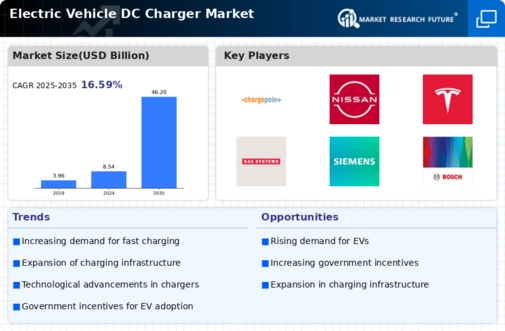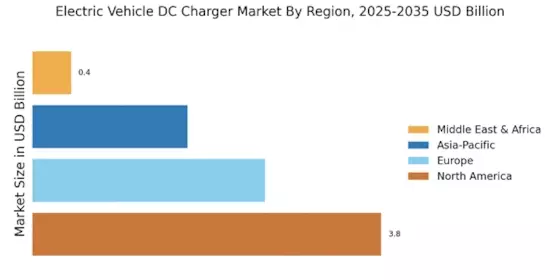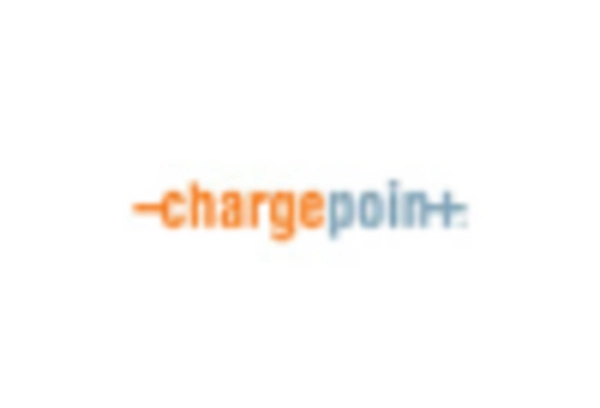Consumer Awareness and Education
Consumer awareness and education regarding electric vehicles and charging solutions are essential drivers for the Electric Vehicle DC Charger Market. As more individuals become informed about the benefits of electric vehicles, including lower operating costs and environmental advantages, the demand for DC charging solutions is expected to rise. In 2025, various campaigns and initiatives aimed at educating the public about EV technology and charging options are likely to gain momentum. This increased awareness can lead to a greater acceptance of electric vehicles, thereby driving the need for a robust DC charging infrastructure. Furthermore, as consumers become more knowledgeable about the availability and advantages of DC chargers, the Electric Vehicle DC Charger Market is positioned to experience growth, reflecting the changing attitudes towards sustainable transportation.
Expansion of Charging Infrastructure
The expansion of charging infrastructure is a vital driver for the Electric Vehicle DC Charger Market. As the number of electric vehicles continues to rise, the demand for accessible and reliable charging stations is becoming more pronounced. In 2025, it is anticipated that the number of public charging stations will increase significantly, with a focus on urban areas and along major highways. This expansion is often facilitated through partnerships between private companies and government entities, aiming to create a comprehensive charging network. The availability of DC chargers in strategic locations enhances the convenience of owning an electric vehicle, thereby encouraging more consumers to make the switch. Consequently, the Electric Vehicle DC Charger Market is likely to benefit from this infrastructure growth, as it directly correlates with increased EV adoption.
Increasing Electric Vehicle Adoption
The rising adoption of electric vehicles (EVs) is a primary driver for the Electric Vehicle DC Charger Market. As consumers become more environmentally conscious, the demand for EVs continues to grow. In 2025, it is estimated that the number of electric vehicles on the road will surpass 30 million units, significantly increasing the need for efficient charging solutions. This surge in EV adoption necessitates a robust network of DC chargers to support the growing fleet. Consequently, manufacturers and service providers are investing heavily in the development and deployment of DC charging infrastructure, which is expected to enhance the overall market landscape. The Electric Vehicle DC Charger Market is thus poised for substantial growth as it aligns with the increasing consumer preference for sustainable transportation options.
Government Incentives and Regulations
Government policies and incentives play a crucial role in shaping the Electric Vehicle DC Charger Market. Many countries have implemented favorable regulations and financial incentives to promote the adoption of electric vehicles and the necessary charging infrastructure. For instance, tax credits, rebates, and grants for EV buyers and charging station installations are becoming commonplace. In 2025, it is projected that government funding for EV infrastructure will reach unprecedented levels, further stimulating market growth. These initiatives not only encourage consumers to transition to electric vehicles but also incentivize businesses to invest in DC charging solutions. As a result, the Electric Vehicle DC Charger Market is likely to experience accelerated expansion due to supportive governmental frameworks.
Technological Innovations in Charging Solutions
Technological advancements are significantly influencing the Electric Vehicle DC Charger Market. Innovations such as ultra-fast charging technology and smart charging solutions are enhancing the efficiency and convenience of charging electric vehicles. In 2025, the market is expected to witness a surge in the adoption of 350 kW DC fast chargers, which can charge an EV in under 20 minutes. These advancements not only improve user experience but also address range anxiety, a common concern among potential EV buyers. Furthermore, the integration of mobile applications for locating charging stations and monitoring charging status is becoming increasingly prevalent. Such technological innovations are likely to drive the growth of the Electric Vehicle DC Charger Market, as they cater to the evolving needs of consumers.


















Leave a Comment